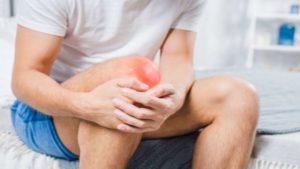Knee Pain Doctor West Chester, PA
Rapid Recovery for Knee Pain

Knee injuries are among the most persistent conditions many people are faced with. Whether it’s due to a sudden trauma or the result of repetitive strain, once damaged and without the proper treatment and rest, the knee can take a very long time to heal. It is not practical to sit out of your life and responsibilities for weeks or months, waiting for the knee to heal itself. A more proactive solution is required. See a knee pain doctor in West Chester, PA at the Premier Osteoarthritis Clinics of Pennsylvania.
Knees play a crucial role in supporting and stabilizing your body weight. The knee is the joint where the upper and lower leg bones meet; in healthy knees the bones, cartilage, muscles, tendons and ligaments all work together. The hinge-like working of the knee joint provides flexibility and strength for standing, walking, running, crouching, jumping, and turning. The pain and reduced mobility from a knee injury or condition can have a major impact on quality of life, making simple everyday activities difficult and painful.
Osteoarthritis: Leading Cause of Knee Problems
Osteoarthritis, the most common type of arthritis, a group of conditions involving inflammation in bone joints, is also called degenerative joint disease or “wear and tear” arthritis. It occurs when the protective surface of the bone cartilage breaks down, making it difficult for joints to fulfil their roles as “shock absorbers” for the body. The body’s weight-bearing joints; the hips, spine and knees – are most susceptible to osteoarthritis. Just as the tread on a car tire thins and eventually starts to unravel, joints can wear out, too.
The end result is bone rubbing against bone. Knee injuries such as fractures, torn cartilage and damaged ligaments can lead to chronic knee pain, but osteoarthritis ranks as the leading cause of serious knee and joint problems.
Causes and Symptoms
Aging is among the main risk factors for developing osteoarthritis, with the highest risk for people over 50. Obesity, a family history of osteoarthritis and being in overall poor health are also risk factors. The first noticeable symptoms are usually pain, stiffness, and reduced flexibility of the knees. The affected area may become swollen due to fluid build-up, further worsening the pain when weight is exerted on the knee.
The symptoms and severity of osteoarthritis tend to worsen over time, so early detection by a knee pain doctor in West Chester, PA is especially important. If you suspect you may have osteoarthritis, there are a number of tools at Premier Osteoarthritis Clinics of Pennsylvania that can help diagnose and assess your condition.
Total Knee Replacement
In cases where non-surgical treatments prove ineffective, surgery is often the best option.
A variety of procedures are available to help repair damaged cartilage and provide pain relief.
For patients with severe cases of osteoarthritis, medical research points to total knee replacement as the most effective treatment option. During the procedure, the damaged knee is replaced with an artificial replacement joint known as a prosthesis which consists of four parts:
- The first part is called the femoral component. This replaces the end of the femur (thigh bone) and is usually made of metal.
- There are two tibial components: a metal tray placed directly on the knee bone and a plastic spacer. These components replace the end of the shin bone, called the tibia.
- The fourth is the patellar component. This part of the knee slides up and down in the femoral groove when the leg bends or straightens.
Knee replacement prostheses typically last 12 to 15 years and can be replaced quite easily when they become worn.
Know your options if you have knee pain
At Premier Osteoarthritis Clinics of Pennsylvania, our other surgical options for treating painful knees include knee fusion, high tibial osteotomy and partial knee replacement. As with all surgical procedures, knee surgery involves some level of risk and potential side-effects such as thrombophlebitis, sometimes called Deep Venous Thrombosis (DVT), infection and stiffness or loosening of the joint. Consult with our knee pain doctor in West Chester, PA today to discuss your options today.

